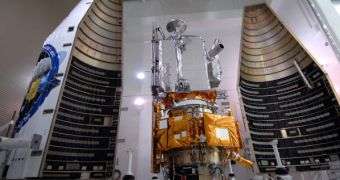The Lunar Reconnaissance Orbiter (LRO), and the Lunar Crater Observation and Sensing Satellite (LCROSS) have been completed, NASA has recently announced, and the two new instruments have already been mated together. The observatories will launch together on the same Atlas V rocket on June 17th, from the Cape Canaveral Air Force Station, in Florida, in very much the same way the European observatories were deployed from the same Ariane 5 delivery system.
“These two missions will provide exciting new information about the moon, our nearest neighbor. Imaging will show dramatic landscapes and areas of interest down to one-meter resolution. The data also will provide information about potential new uses of the moon. These teams have done a tremendous job designing and building these two spacecraft,” NASA's Exploration Systems Mission Directorate Associate Administrator Doug Cooke, from Washington DC, said of the now-completed effort.
The LRO will sport seven different astronomical instruments, which will help mission controllers identify the best possible landing sites for future manned exploration missions, locate potential resource concentrations, find out the threat level posed by radiation in the lunar environment, as well as test a number of new technologies, which may soon be employed on our nearest neighbor. On the other hand, LCROSS will focus its efforts on the satellite's poles, in an attempt to determine for sure if liquid or ice water exists under a thin layer of sand, such as is the case on Mars.
“LRO is an amazingly sophisticated spacecraft. Its suite of instruments will work in concert to send us data in areas where we've been hungry for information for years,” LRO Project Manager Craig Tooley, who is working out of NASA's Goddard Space Flight Center, in Greenbelt, Maryland, added.
“We look forward to engaging a wide cross section of the public in LCROSS' spectacular arrival at the moon and search for water ice. It's possible we'll learn the answer to what is increasingly one of planetary science's most intriguing questions,” LCROSS Project Manager Dan Andrews, from the agency's Ames Research Center, in Moffett Field, California, shared.
The LCROSS will use the second stage of the Atlas Centaur booster in a very unusual way. Rather than jettisoning from it once in orbit, it will pull the stage behind it for about four minutes, and then set it on a course that will crash it at a lunar pole. The ensuing plume is expected to be about six miles high, and a suite of Earth- and orbit-based telescopes, including maybe even the Hubble Space Telescope, and, naturally, LCROSS, will study the dust for signs of ice water.

 14 DAY TRIAL //
14 DAY TRIAL //